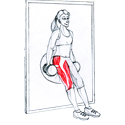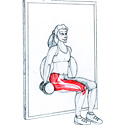-

|
-

|
| Step 1 |
Step 2 |
- Targeted Muscles:
- Hamstring
- Quadriceps
- Hip Flexors
- Additional Muscles:
- Deep Abdominal Muscles (transverse abdominis)
- Inner Thighs (adductors)
- Lower back (erector spinae)
- Buttocks (gluteus maximus)
- To make the exercise harder, perform the exercise except extend your left leg straight out in front of you with your knee slightly bent before lowering into the squat position. To avoid putting too much pressure on your supporting leg, lower only about one third of the distance you would normally lower for a full squat. After completing a set, repeat the exercise with your right leg extended. Performing wall squats on one leg focuses more on strengthening the muscles around your knee and is useful when you want to strengthen your legs equally.
- To perform this exercise without using the wall, standing with your left side facing the ball, extend your left leg straight out to the side and place the inside of your left foot and ankle on top of the ball. Then lower about one-third the distance of a full squat, keeping your foot on the ball. After completing a set, switch legs and repeat the exercise.
- The wall squat tones your entire lower body, strengthening your quadriceps, buttocks, hamstrings, hip flexors and inner thighs. This is an excellent exercise for developing strong, well-toned legs, which help increase your endurance when performing activities such as walking or riding a bike. If you have lower back problems, be careful performing this exercise.
- Using a ball makes wall squats easier and is a good way for beginners to start performing squats.
- When you lower into the squat, make sure you do not move your buttocks forward as you squat and your knees do not extend past your toes. As you raise back to the starting positions, concentrate on pushing up through your heels rather than through the balls of your feet. If you want to add an extra challenge, you can hold a dumbbell in each hand with both arms at your sides and your palms facing in as you perform the exercise
- Do not allow your knees to pass your toes.
- Do not move your buttocks forward. Move your upper body and buttocks straight down.
- Do not tilt your head up or down. Keep your head, neck and back in a straight line.
- Do not lock your knees.
|











